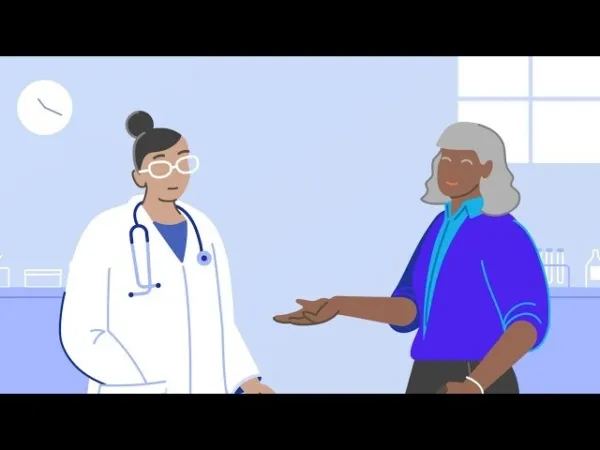Understanding pancreatic cancer early
Learning more about the possible symptoms of pancreatic cancer, the stages in which they occur and how the Galleri® test can help.
Galleri screens for many of the deadliest cancers before they become symptomatic, including those with no recommended screening tests today, such as pancreatic or ovarian.1,3,4*
The Galleri test does not detect a signal for all cancers and not all cancers can be detected in the blood. False positive and false negative results do occur. The Galleri test should be used in addition to healthcare provider recommended screening tests.

The Galleri test does not detect a signal for all cancers and not all cancers can be detected in the blood. False positive and false negative results do occur. The Galleri test should be used in addition to healthcare provider recommended screening tests.
Risks Associated with Pancreatic Cancer2,5
Understanding how these factors apply to you could help you make decisions about screening for prostate cancer:
- Age: The risk of pancreatic cancer increases with age, with most cases occurring in individuals over 65.
- Sex: Men are slightly more likely to develop pancreatic cancer than women. This may be due, at least in part, to higher tobacco use in men, which raises pancreatic cancer risk.
- Genetic Predispositions: There are a variety of inherited genetic mutations and syndromes associated with a higher risk of getting pancreatic cancer, including but not limited to BRCA/BRCA2, Cystic Fibrosis, FAP, FAMM, etc.
- Ethnicity: African Americans have a slightly higher incidence of pancreatic cancer compared to individuals of Asian, Hispanic, or Caucasian descent. The correlation is not clear, but non-Hispanic African Americans are more likely to be diagnosed with diabetes, a known risk factor for pancreatic cancer.
- Obesity: Having excess body weight (overweight or obesity) is a risk factor for pancreatic cancer. People with obesity (body mass index [BMI] of 30 or more) are about 20% more likely to develop pancreatic cancer.
Symptoms of Pancreatic Cancer2,3,5
- Jaundice: Yellowing of the skin and eyes, often accompanied by dark urine and light-colored or greasy stools. This occurs when a tumor blocks the bile duct, leading to a buildup of bilirubin in the body.
- Abdominal or Back Pain: Persistent pain in the upper abdomen or back, which may result from the tumor pressing on nearby organs or nerves.
- Unintended Weight Loss and Poor Appetite: Significant weight loss without trying and a noticeable decrease in appetite are common in pancreatic cancer patients.
- Nausea and Vomiting: If the tumor presses on the stomach, it can cause nausea, vomiting, and a feeling of fullness.
- Gallbladder or Liver Enlargement: A blocked bile duct can cause bile to accumulate, enlarging the gallbladder or liver. This may be detected during a physical exam or imaging tests.
- Blood Clots: Cancer causes changes in the blood that can increase the likelihood of forming clots. Blood clots may go unnoticed and cause no symptoms.
- New-Onset Diabetes: Pancreatic cancer can impair the pancreas's ability to produce insulin, leading to diabetes. Symptoms include increased thirst, hunger, and frequent urination.
It's important to note that these symptoms can be caused by conditions other than pancreatic cancer. However, if you experience any of these symptoms, especially in combination, it's crucial to consult a healthcare professional promptly. Early detection can significantly impact treatment options and outcomes.
Requesting Galleri
Available by prescription only
Ask your healthcare provider if the Galleri test is right for you. Our discussion guide can help start the conversation and includes a request form your provider can complete to place an order.

50+ types of cancer identified2
The Galleri test screens for a signal shared by over 50 cancer types, most lacking recommended screening tests.1,4 In a clinical study with a shared cancer signal, adding the Galleri test to recommended single-cancer screening approximately doubled the number of cancers detected with recommended screening alone.2
Today, doctors screen individually for 5 specific cancers — colorectal, lung (for those at risk), breast, cervical, and prostate. While these single-cancer screenings play an important role, adding the Galleri test allows you to go beyond these 5 cancers to screen for additional cancers, such as stomach and pancreatic.1,4*
Galleri is a screening test and does not diagnose cancer. Diagnostic testing is needed to confirm cancer. The Galleri test does not detect a signal for all cancers and not all cancers can be detected in the blood.
*Sensitivity in study participants with stomach cancer was 66.7% overall (16.7% for stage I, 50.0% stage II, 80% stage III, 100% stage IV), and pancreatic cancer was 83.7% overall (61.9% for stage I, 60.0% stage II, 85.7% stage III, 95.9% stage IV).

While these single-cancer screenings play an important role in detecting 5 specific cancers today, we can do more.
When cancer is diagnosed early,* before it has time to spread, the overall 5-year cancer-specific survival rate is 4 times higher than when cancer is diagnosed late.8*
*“Early/Localized” includes invasive localized tumors that have not spread beyond the organ of origin; “Late/Metastasized” includes invasive cancers that have metastasized beyond the organ of origin to other parts of the body.
Learn about Roger's Story
Battling Pancreatic Cancer with the Galleri Test

Sign up for more information about Galleri
- US Preventive Services Task Force. A,B,C grade recommendations, cancer, screenings. [cited 2023 Oct 23]. https://www.uspreventiveservicestaskforce.org/uspstf/topic_search_results
- American Cancer Society. Cancer facts & figures 2022. https://www.cancer.org/research/cancer-facts-statistics/all-cancer-facts-figures/cancer-facts-figures-2022.html [GRAIL, LLC. Data on file: GA-2021-0065]
- https://www.cancer.org/cancer/types/pancreatic-cancer/detection-diagnosis-staging/staging.html
- Klein EA, Richards D, Cohn A, et al. Clinical validation of a targeted methylation-based multi-cancer early detection test using an independent validation set. Ann Oncol. 2021 Sep;32(9):1167-77. doi: 10.1016/j.annonc.2021.05.806
- PanCan: https://pancan.org/facing-pancreatic-cancer/about-pancreatic-cancer/risk-factors/